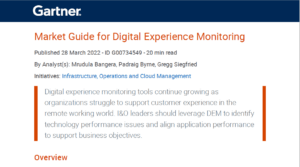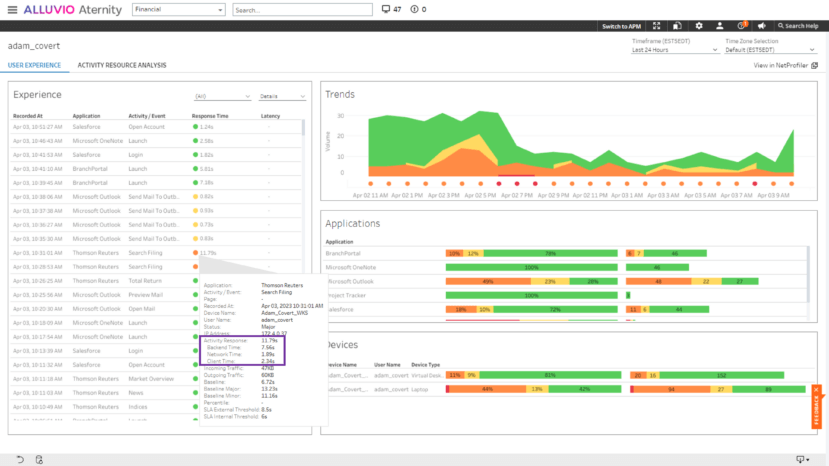Organizations use End User Experience Management (EUEM) to ensure that their technology systems are functioning effectively when it comes to delivering excellent digital experiences to end users. The goal is to ensure users are able to access the resources they need to perform their jobs (in the case of employees) or to interact with a company (in the case of consumers).

End User Experience Management is an important consideration for businesses of all sizes, as it can have a significant impact on the productivity of the workforce, the satisfaction of customers, and ultimately the success of the organization. At its core, EUEM is focused on providing a positive experience for end users, whether they are employees, customers, or partners. This can involve a range of capabilities, including monitoring, analytics, and implementing strategies for improving the performance of system, application, and devices.
As clear as this sounds, vendors and thought leaders in the market make it confusing by using a variety of related terms to describe this goal. Digital Experience Monitoring, Digital Experience Management, and Digital Employee Experience Management are all different names for similar categories of software. Review the Gartner Market Guide for Digital Experience Monitoring for a good overview of representative vendors.
The role of monitoring in EUEM
Monitoring is a key foundational element of End User Experience Management. This involves tracking the performance of various components of the technology environment that affect user experience, including devices, servers, applications, and network resources. By collecting data on these elements, and correlating them together, businesses can gain insight into the root causes of performance issues negatively affecting end user experience and identify opportunities for improvement.
For example, if users are experiencing slow load times when accessing a particular application, IT can use end user experience monitoring tools to track the performance of the application and identify any bottlenecks or other issues that may be causing the problem. Products like our Riverbed Aternity Digital Experience Management Platform enable IT to isolate the source of slowness to the employee device, the network, or the back-end application service. IT can then further investigate the root cause and take appropriate action to improve it. It’s important to note that monitoring metrics that indicate the performance of devices, systems, and applications is necessary, but not sufficient for effective end user experience management. Device performance management is not the same as end user experience management. It’s just one of the factors.

How analytics drives End User Experience Management
Another important element of EUEM is analytics. By collecting and analyzing data on user activity and system performance, businesses can gain insight into how their technology systems are being used and identify opportunities for improvement. This can involve analyzing data on user behavior, such as how often they access particular applications or the application response time they experience when performing certain tasks within a business-critical application.
Most EUEM products enable IT to proactively identify and address issues before they become major problems. By monitoring system performance and analyzing user behavior, businesses can identify potential issues early on and take steps to prevent them from causing significant disruptions. Products like Riverbed Aternity contain Riverbed IQ capabilities to address the most commonly expected end user issues. With automated remediation, IT can often remedy an end user experience issue even before employees notice. Watch this short video to see automated remediation in action:
What is an example of end user experience?
The performance of an application or website is a common example of end user experience that everyone is familiar with. End users expect applications and websites to load quickly and be responsive. If an application takes a long time to load or is slow to respond to user inputs, user experience suffers. This can have a major impact on the business. For example, data from Hobo shows the following:
- The ideal website load time for mobile sites is 1-2 seconds.
- 53% of mobile site visits are abandoned if pages take longer than 3 seconds to load.
- A 2-second delay in load time resulted in abandonment rates of up to 87%.
Other technical factors that can impact the end user experience include network connectivity, server availability, and the quality of the user interface. For example, if a user is accessing an application over a slow or unreliable network connection, this can lead to poor performance and frustration. Similarly, if a server is experiencing high levels of traffic, this can lead to slow load times and other performance issues.
The challenge for IT is that with so many employees working from home, factors such as Wi-Fi signal strength and ISP bandwidth and performance also affect end-user experience. But those factors are outside of the direct control of IT. IT requires a monitoring system like that ingests telemetry from all across the IT environment, then analyzes them to identify issues.
Why is improving end user experience important?
Using End User Experience Management to provide a seamless and responsive user experience enables businesses to improve their workforce productivity and customer satisfaction. Benefits include the following:
For employees:
- Increased productivity: If employees have access to technology systems that are fast, reliable, and easy to use, they can perform their tasks more efficiently, which improves productivity.
- Reduced frustration and stress: If employees are able to use technology systems without experiencing performance issues, they are likely to feel less frustrated and stressed, which can improve morale and job satisfaction.
- Improved job performance and retention: Employees who are satisfied with their technology systems are more likely to stay with their current employer.
For consumers:
- Enhanced satisfaction and loyalty: If consumers have a positive experience when using a company’s technology systems, they are more likely to be satisfied with the company’s products or services and become loyal customers.
- Increased sales and revenue: Customers who have a positive experience are more likely to make repeat purchases and recommend the company to others, which can lead to increased sales and revenue.
- Improved brand reputation: Companies that prioritize end user experience and provide a positive experience for their customers are likely to develop a strong reputation for quality and customer service, which can help attract new customers and retain existing ones.
How has hybrid work changed the importance of end user experience management?
 The prevalence of hybrid or remote work has increased the importance of end user experience management for several reasons:
The prevalence of hybrid or remote work has increased the importance of end user experience management for several reasons:
Increased reliance on technology
With more employees working remotely, businesses are relying on technology systems to facilitate communication, collaboration, and productivity. With this, end user experience has become even more critical, as employees need technology systems that are fast, reliable, and easy to use in order to perform their tasks effectively.
Greater complexity
Hybrid or remote work environments can be more complex than traditional office environments, with employees accessing systems and applications from multiple locations and devices. This added complexity can make it more difficult to manage and optimize the end user experience.
Heightened security concerns
Remote work also brings with it heightened security concerns, as employees may be accessing sensitive company data from unsecured networks or devices. Ensuring a positive end user experience while maintaining robust security measures requires businesses to find a balance between security and ease of use.
Increased competition for talent
With the rise of remote work, businesses are no longer limited to hiring employees from their local area. This means that businesses are competing with a wider range of companies for top talent, and end user experience can be a key factor in attracting and retaining employees in a low unemployment market.
Here’s an overview of how Riverbed helps address these hybrid work challenges.
Five steps to improve end user experience
Improving end user experience can be challenging when IT budgets are tight. However, there are several practical ways that businesses can improve end user experience while watching expenses.
- Conduct an end user experience assessment: Assessing current systems and processes can help identify areas of inefficiency or frustration for end users and can provide insights into how to improve the overall experience. Companies use periodic surveys to gather employee experience data, but they can also do the same with their EUEM tools.
- Prioritize user feedback: User feedback is an invaluable tool for improving end user experience. By prioritizing user feedback and making changes based on that feedback, businesses can demonstrate that they value their employees’ and customers’ feedback.
- Optimize existing systems: Often, businesses have existing systems and processes that can be optimized to improve end user experience. This might include removing unnecessary steps from a process, streamlining workflows, or optimizing the performance of existing technology systems.
- Implement self-service tools: Self-service tools, such as knowledge bases or chatbots, can help reduce frustration for end users by providing them with quick and easy access to information or assistance. These tools can be relatively inexpensive to implement and can help improve end user experience by reducing wait times and increasing accessibility.
- Provide training and support: Providing training and support to end users can also help improve the overall experience. This might include offering training sessions on new systems or processes or providing dedicated support personnel to help troubleshoot technical issues.
Overall, improving end user experience doesn’t necessarily require a large investment of money. By prioritizing user feedback, optimizing existing systems, implementing self-service tools, and providing training and support, businesses can make meaningful improvements to the end user experience even in restricted budget environments.
Take the first step to better end user experience now
You can explore end user experience management now by registering for a Request Demo of Riverbed Aternity. Download our software to understand how our approach to end user experience management helps you reduce costs, improve productivity, and deliver better customer satisfaction.
